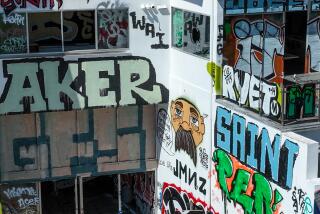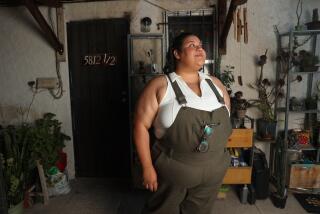House Arrest : Crime: Authorities put a stop to dealing and drug use at a Boyle Heights property by boarding it up. Neighbors greet the action with relief.
- Share via
For more than a decade, the yellow clapboard house was the shame of East 2nd Street in Boyle Heights.
Heroin addicts would pass out in the front yard or in the three-foot crawl space beneath the house after shooting up. Three times they set fire to the place while trying to heat drugs in spoons--most recently sparking a conflagration that burned down the garage in the back.
Junkies who used the house as a hangout would prowl the neighborhood. They would steal batteries and spare tires from cars, rakes and garden hoes from storage sheds and even puppies from fenced-in yards to sell.
But all that changed Tuesday as police rousted one last occupant from the house and boarded up its doors and windows as a crowd of neighbors watched.
City and federal authorities seized the ramshackle three-bedroom house under the narcotics asset forfeiture program and announced that it will either be cleaned up and sold--or bulldozed.
“Thank God!” said Maria Iniguez, who lives down the street from the house. “This can be a good neighborhood again.”
“The people in there were not good people,” said Dalfiena Trothez, who lives across the street and watched from her front yard as authorities blocked off the street and moved in. “Today’s my birthday--I’m 53. This is a very good gift. The best I could get.”
Tuesday’s property seizure was conducted under a narcotics abatement project called FALCON, short for Focused Attack Linking Community Organizations and Neighborhoods. It is made up of Los Angeles police, the city attorney’s office and the Building and Safety Department, which work with the FBI and U.S. marshals.
The Boyle Heights property seizure was one of two Tuesday. Authorities also seized a 10-unit apartment building on West 84th Place in South-Central Los Angeles that they said has turned into a hangout for narcotics users and gang members.
Under asset forfeiture laws, property owners can lose title to their property if they do not assist authorities in preventing illegal activities there. Los Angeles officials have used public nuisance abatement laws to close crack houses and drug-infested apartments since a 1972 state anti-drug statute took effect.
Such seizures have been criticized by some for trampling on property owners’ rights and unfairly shifting enforcement of drug-dealing laws from police to those with private property. But nothing but cheering could be heard Tuesday along 2nd Street.
“It was hell, day and night,” said a woman who lives nearby but did not give her name for fear of “retaliation by those bums.”
A neighbor who lives a block away said: “You hated to invite anybody to your home because their cars would get broken into while they were here. You couldn’t leave anything in your yard. They’d even steal puppies to sell.”
Neighbor Delta Becerra said a woman living in the clapboard house chased her down the street one day trying to steal her purse. “I ran inside and locked the door. I was always worried about my four kids,” Becerra said.
Her 13-year-old son, Enrique, said drug addicts could sometimes be seen passed out on a couch in the home’s front yard. “I’m glad to see them gone,” he said.
Officials said the house was owned by 45-year-old Louie Velasquez Aguirre, who inherited it from his mother after she died in 1981.
Aguirre was unavailable for comment. But Los Angeles Police Cmdr. James Jones described him as unable to control the comings and goings at the house.
Jones said Aguirre “didn’t even want to live here--he’s been staying at a motel.”
Narcotics Officer John Thomas said half a dozen drug arrests have been made at the house in the last three months. The most recent occurred just hours before authorities arrived to board up the place.
He said it was clear to everyone in the neighborhood--which is bordered by a pair of churches on the east and west and a public library and an elementary school on the north and south--what was going on in the clapboard house.
Once, while visiting the principal’s office at Breed Street Elementary School directly behind the house, he glanced out the window and saw drug dealing in the back yard.
“There’s a lot of gratitude on this street today,” said FBI Agent Kathleen McChesney, who assisted in the seizure. “Children who live here deserve better than to live in a blighted area or have to walk around stepping on needles.”
More to Read
Sign up for Essential California
The most important California stories and recommendations in your inbox every morning.
You may occasionally receive promotional content from the Los Angeles Times.











